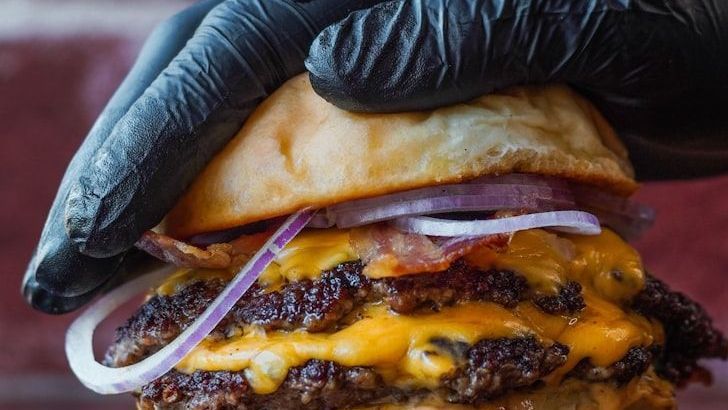
Here’s a wild burger truth: the most explosive beef flavor in New York City is hiding in a paper-thin crust just millimeters thick, born the instant ground beef hits a ripping-hot griddle. In Bon Appétit’s Made to Order episode published on September 25, 2025, burger scholar George Motz shows exactly how that crust happens, why it matters more than anything, and how a humble stack of beef, onions, cheese, and a soft bun can feel downright legendary. The video doesn’t rely on flashy tricks or fancy toppings; it’s a love letter to technique and tradition. Watching Motz at Hamburger America is like seeing a time-honored craft practiced at full speed and full confidence. It’s fast, loud, sizzling, and—let’s be honest—pretty irresistible. If you’ve ever wondered why a proper smash burger tastes so much bigger than it looks, this is the masterclass you were waiting for.
Why Smash Burgers Hit Different in NYC
New York loves bold flavors and quick cooking, which is exactly what a smash burger delivers, and Motz embraces that energy from the first sizzle. The defining move is the smash itself: pressing a loose ball of beef hard and early on a blazing hot surface to create maximum contact and a lacey, caramelized edge. That crust concentrates beefy depth in a way a thicker patty simply can’t, making every bite louder, saltier, and more satisfying. In the video, you can practically hear the Maillard reaction doing the heavy lifting as the patty fuses with the griddle for a few crucial moments. Motz keeps the process intentionally simple because it’s the heat, pressure, and timing that write the flavor story, not a mile-long list of toppings. New York’s pace also suits the smash: it’s fast to cook, easy to assemble, and made to be eaten hot off the line.
The style’s appeal also comes from its balance, which Motz treats as non‑negotiable. A thin patty needs a soft bun to cushion it, a slice of American cheese to melt into every nook, and just enough onion or pickle to cut the richness. That restraint keeps the burger from feeling heavy even when you go double, which many New Yorkers understandably do. The result is a burger with huge personality but zero fuss, a trait that feels quintessentially NYC. It’s classic, not nostalgic; current, not trendy; and most importantly, it tastes like something worth leaving the house for.
George Motz and the Hamburger America Philosophy
George Motz isn’t just cooking burgers; he’s preserving a living piece of American food culture. As the owner of Hamburger America and a lifelong burger historian, he treats every detail as part of a bigger story about regional traditions, old griddle techniques, and the people who kept them alive. In the Bon Appétit feature, that perspective shows up in his minimalism: fewer ingredients, more respect for the process, and a focus on repeatable results. He talks about burgers the way a pitmaster talks about smoke—patiently, precisely, and with a sense that you’re joining a lineage when you do it right. That’s why his burgers feel familiar even if it’s your first bite; the method is rooted in decades of American diner wisdom. The goal isn’t reinvention for its own sake, but restoration of what made the original so great.
Hamburger America serves as Motz’s museum and workshop rolled into one. It’s where he proves that quality grinds, hot steel, and careful timing beat novelty every single time. The restaurant champions the smash style that shaped so much of NYC’s burger scene and gives it a clean, confident platform. In the episode, Bon Appétit captures that rhythm beautifully: quick portions, immediate smash, clean flip, melt, and build. You see a system that’s been refined until it looks almost effortless, which is exactly how you know how much thought went into it. It’s the culinary equivalent of a perfect three‑chord song—simple on paper, unforgettable in practice.
The Meat: Grind, Fat Ratio, and Portioning
Motz starts with fresh ground beef that carries a real beefy aroma before it even hits the griddle, and that detail matters more than any topping. An 80/20 lean‑to‑fat ratio is the sweet spot because it guarantees sizzle, browning, and juiciness without turning greasy. The fat renders into the crust during the smash, whisking flavor deep into the patty while crisping the edges. He portions small so the meat can spread thin under pressure, which is how you get that signature laced border and delicate crunch. Seasoning is minimal—usually just salt, sometimes pepper—because the point is to highlight the meat, not bury it. When the raw materials are this dialed in, restraint becomes a kind of generosity to the eater.
The other quiet hero is temperature management and handling. Motz treats the beef gently, forming loose balls rather than tight pucks so steam can escape and browning can accelerate. Overworking the meat would make it dense and rubbery, a mistake that kills the light, crisp texture you want. He also moves quickly from portion to griddle; fresh beef plus high heat equals instant aroma and a better crust. All of this builds toward a clean, beef‑forward flavor that holds up even with a second patty. It’s engineering by way of appetite, and it works shockingly well.
Sear Science: Griddle Heat, Smash Timing, and the Flip
Heat is the entire ballgame, and Motz treats the griddle like a precision instrument. He drops the beef onto a fully preheated surface, then smashes hard and fast to lock in contact before moisture has time to pool. The first seconds create the crust’s foundation, and he avoids pressing again later so the juices don’t squeeze out. A thin metal scraper becomes essential for the flip; it slides under the patty to release those browned bits you absolutely want attached to the meat, not stuck to the steel. Cheese goes on while the second side finishes so it melts through the nooks of the crust instead of just sitting on top. The rhythm is swift—smash, set, scrape, flip, melt—and every beat exists to protect the crust.
“The crust is the flavor.”
That idea runs through the whole cook and explains Motz’s minimalism better than any recipe card. If the griddle isn’t hot enough, you’ll steam instead of sear, and the burger will taste flat no matter how fancy the toppings are. If you smash too late, you miss the window for real contact and lose that shimmering, lacey edge. If you flip too early, the crust tears; too late, it dries. Watching the episode, you can tell he’s measuring with his eyes and ears—listening for the sizzle, watching for browned edges, and moving with intent. It’s craft, not guesswork, and that’s why the results hit so hard.
Buns, Cheese, Onions, and Sauce: Building Flavor the Motz Way
Motz chooses a soft, slightly sweet bun because it compresses around the patty without fighting it, turning each bite into a neat, juicy package. He lightly toasts the cut sides so the bun stands up to the heat and moisture, adding a whisper of extra flavor and texture. American cheese is the pick for one simple reason: it melts perfectly, slipping into every pore of the crust and acting like a savory glue. Onions bring brightness, and whether they’re griddled, thinly shaved, or tucked under the patty, they lift the richness without stealing the show. Pickles add snap and acidity, a clean reset that keeps you chasing the next bite. Sauce stays restrained—think a swipe of special sauce, mustard, or ketchup—because the beef has already done the heavy lifting.
This balance is where the burger gets its personality, and Motz doesn’t let a single element get loud enough to drown out the others. The bun is the stage, the cheese is the spotlight, the onions and pickles are the chorus, and the crusted beef is the headliner. In the Bon Appétit feature, that build happens fast but never feels rushed, which is a testament to repetition and discipline. The final stack is compact, grabbable, and built to be eaten hot, not photographed for a half hour. You taste heat, salt, fat, and sweetness in a tight little arc that lands with a crunch. It’s a careful design hiding inside a casual sandwich.
How to Recreate the Hamburger America Burger at Home
You don’t need a restaurant setup to channel what Motz shows on camera; you just need heat, timing, and good beef. A heavy cast‑iron skillet or flat‑top griddle and a stiff metal spatula will take you most of the way there. Preheat until a drop of water skitters aggressively, because timid heat makes timid burgers. Keep your beef cold and loosely portioned, and don’t overthink the seasoning—salt is plenty, pepper if you like. Get your bun toasted and your cheese unwrapped before you ever touch the meat so nothing slows you down. The best home smash burgers happen when you move like a short‑order cook, not like you’re filming a cooking show.
- Preheat a cast‑iron skillet or griddle until very hot; have buns split and toasting set‑up ready.
- Form loose 2 to 3 ounce balls of 80/20 beef; season lightly with salt just before or right after the smash.
- Drop the beef onto the hot surface and immediately smash firmly and evenly; do not press again later.
- Let the crust set, then scrape cleanly and flip; top with American cheese so it melts into the crust.
- Build on a soft toasted bun with thin onion, pickles, and restrained sauce; serve and eat immediately.
A couple of common pitfalls are easy to fix: if your burger is pale, your pan wasn’t hot enough; if it’s tough, you likely overworked the beef or pressed after the crust formed. If it sticks, your scraper isn’t thin enough or you waited too long to flip. Keep batches small so you don’t crash the pan temperature, and resist the urge to overload with toppings. The goal isn’t a tall burger; it’s a perfectly balanced one. Master that balance, and your kitchen will suddenly feel a lot closer to Hamburger America.
So, after seeing George Motz and Bon Appétit bring the smash to life on a roaring griddle, what part will you nail first: the fearless smash, the clean flip, or the melt that seals the deal?
Source: Original YouTube Video





